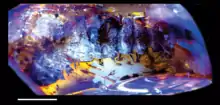Balumtum-Sandstein
Balumtum-Sandstein ist ein Bernstein-führender Sandstein, der in der Periode des Neogen entstanden ist. Er gehört zur Formation des Chiapas Thrust-Fold Belt (Central & Eastern Thrust-fold Belt) in Mexiko und zeichnet sich durch eine große Anzahl von Insekten-Fossilien (Chiapas-Bernstein) aus.
Der Sandstein kommt im Gebiet von Simojovel in Chiapas, Südwest-Mexiko vor. Er ist zum Beispiel in den Totalapa Amber bearing Beds zugänglich. Man geht davon aus, dass die Ablagerungen im Miozän, speziell in den Abschnitten Langhium und Burdigalium (21 – 13 Millionen Jahre), entstanden sind. Die Struktur ist dichtgepackt und stark „zementiert“. Molluskenfunde und Insekten- und Gliederfüßer-Einschlüsse im Bernstein, sowie Lignite deuten darauf hin, dass es sich um kontinentale Ablagerungen handelt.
Der Balumtum-Sandstein liegt auf dem Mazantic-Schiefer auf und wird von Santo-Domingo-Sandstein überlagert.
Fossilien

- Tityus apozonalli
- Anbarrhacus adamantis (Tausendfüßler)
- Aphaenogaster praerelicta (Ameise)
- Culoptila aguilerai (Fliege)
- Dicromantispa electromexicana (Fanghaft)
- Hyptia deansi (Wespe)
- Leptopharsa tacanae (Käfer)
- Maatidesmus paachtun (Tausendfüssler)
- Mastotermes electromexicus (Termite)
- Parastemmiulus elektron (Tausendfüssler)
- Schwenckfeldina archoica (Pilzmücke)
- Termitaradus protera (Termitenwanze)
- Tonocatecutlius sp. (Grashüpfer)
- Tityus knodeli (Skorpion)
- Tesserocerus simojovelensis (Peris & Solórzano Kraemer, 2015) (Ambrosiakäfer)
- Cenocephalus tenuis (Peris and Solórzano Kraemer 2015) (Ambrosiakäfer)
- Mesorhaga pseudolacrymans (Bickel 2016) (Langbeinfliege)
- Amblypsilopus monicae (Bickel 2016) (Langbeinfliege)
- Medetera totolapa (Bickel 2016) (Langbeinfliege)
- Medetera amissa (Bickel 2016) (Langbeinfliege)
- Peloropeodes paleomexicana (Bickel 2016) (Langbeinfliege)
- Neoparentia chiapensis (Bickel 2016) (Langbeinfliege)
Literatur
- Richard Case Allison: The cenozoic stratigraphy of Chiapas Mexico with discussions of the classification of the Turritellidae and selected Mexican representatives. Ann Arbor, Michigan: University Microfilms International, 1999. Diss.: (Ph. D.)--University of California, 1967.
- María del Carmen Perrilliat; Francisco J. Vega; Marco A. Coutiño: Miocene mollusks from the Simojovel area in Chiapas, southwestern Mexico 1999. In: ‘’Journal of South American Earth Sciences’’ 30(2): 111-119 · November 2010 Elsevier Ltd auch:
- S. D. Webb, B. L. Beatty, and G. Poinar, Jr.: ‘’New evidence of Miocene Protoceratidae including a new species from Chiapas, Mexico.’’ In: Bulletin of the American Museum of Natural History 279: 348-367 [J. Alroy/J. Alroy/J. Alroy] 2003.
- Claudia Durán-Ruiz; Francisco Riquelme; Marco Coutiño-José; Gerardo Carbot-Chanona; Gabriela Castaño-Meneses; Mario Ramos Arias: Ants from the Miocene Totolapa amber (Chiapas, México), with the first record of the genus Forelius (Hymenoptera, Formicidae). In: Canadian Journal of Earth Sciences 2013, 50: 495-502. (mit schematischer Darstellung der Stratigraphie)
- Rodney Feldmann; Francisco Vega; Annette B. Tucker; Pedro García-Barrera; Javier Avendaño: The oldest record of Lophoranina (Decapoda: Raninidae) from the Late Cretaceous of Chiapas, Southeastern Mexico. In: Journal of Paleontology. 1996, 70. 296-303. 10.1017/S0022336000023386.
- Gérard Breton; María de Lourdes Serrano-Sánchez; Francisco J. Vega: Filamentous micro-organisms, inorganic inclusions and pseudo-fossils in the Miocene amber from Totolapa (Chiapas, Mexico): taphonomy and systematics. (Microorganismos filamentosos, inclusiones orgánicas y pseudofósiles en el ámbar miocénico de Totolapa (Chiapas, México): tafonomía y sistemática.) In: Boletín de la Sociedad Geológica Mexicana vol.66 no.1 México abr. 2014. ISSN 1405-3322